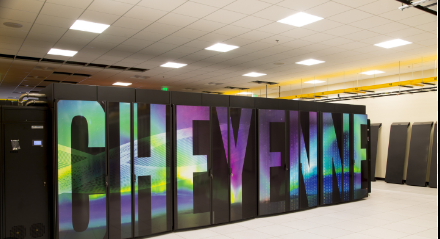NCAR's Cheyenne Supercomputer: Powering Earth Science Research (2017-2024)

Exploring Earth's Systems: How NCAR's Cheyenne Supercomputer Advanced Research
The vastness of Earth's systems, from the intricate dance of weather patterns to the delicate balance of the climate, demands immense computational power for scientific exploration. Enter NCAR's Cheyenne supercomputer, a technological marvel housed at the NCAR-Wyoming Supercomputing Center (NWSC) in Cheyenne, Wyoming.
NCAR: Championing Earth System Science
The National Center for Atmospheric Research (NCAR) is a cornerstone institution in the United States, dedicated to advancing our understanding of the Earth's atmosphere and its interconnected systems. NCAR accomplishes this mission through a multi-pronged approach, including:
Observational Efforts:
NCAR operates a vast network of ground-based and atmospheric observation systems, collecting real-time data on everything from weather phenomena to atmospheric composition.
Theoretical Research:
NCAR scientists develop and refine complex mathematical models that represent the physical and chemical processes governing Earth's systems.
Computational Power:
This is where Cheyenne comes in. NCAR leverages the immense processing power of Cheyenne to run these sophisticated models, simulating Earth's behavior and providing invaluable insights.
The Rise of Cheyenne: A Supercomputing Powerhouse
Cheyenne, deployed in 2017, marked a significant leap forward in NCAR's computational capabilities. Previously, Yellowstone, the center's earlier supercomputer, had served researchers well. However, Cheyenne tripled Yellowstone's processing power, boasting a staggering 5.34 petaflops.
For the uninitiated, a petaflop is a mind-boggling unit of computing power, signifying the ability to perform a quadrillion (one thousand trillion) floating-point operations per second.
In simpler terms, Cheyenne churn through an unimaginable number of calculations in a single second, allowing researchers to tackle complex Earth science problems with unprecedented detail and resolution.
The Brains Behind the Brawn: Building the Cheyenne Supercomputer
Cheyenne is a testament to cutting-edge supercomputing technology. Built by Silicon Graphics International (SGI), the system utilizes an SGI ICE XA Cluster architecture. This translates to a network of interconnected processing units, each a powerhouse in its own right.
At the heart of Cheyenne lie over 145,000 Intel Xeon processor cores, meticulously distributed across thousands of individual compute nodes.
This massively parallel processing architecture allows Cheyenne to break down complex simulations into smaller, more manageable tasks, tackling them simultaneously for unparalleled processing speed.
Beyond Processing Power: Storage and Networking
Raw processing power is just one piece of the puzzle. To effectively utilize Cheyenne's capabilities, researchers need a robust data storage and networking infrastructure. Cheyenne boasts a hefty 315 terabytes of memory, allowing scientists to readily access frequently used data during simulations.
Additionally, a high-performance DataDirect Networks (DDN) storage system provides an initial capacity of 20 petabytes, expandable to a staggering 40 petabytes as needed.
This immense storage capacity ensures that the vast amounts of data generated by Cheyenne's simulations are readily available for analysis.
The high-performance Mellanox EDR InfiniBand network serves as the communication backbone of Cheyenne. This network allows for rapid data exchange between compute nodes, ensuring all parts of the system work in seamless coordination during simulations.
Cheyenne in Action: Powering Earth Science Research
The applications of Cheyenne's immense power span the vast spectrum of Earth science research. Here are a few key areas where Cheyenne is making a difference:
Weather Forecasting: Cheyenne allows researchers to develop and run more sophisticated weather models, leading to more accurate and longer-range weather forecasts. This translates into better preparedness for extreme weather events, potentially saving lives and property.
Climate Change Research: Understanding the complex interplay of factors contributing to climate change requires intricate simulations. Cheyenne's power allows researchers to model future climate scenarios with greater detail, providing valuable insights for policymakers and mitigation strategies.
Space Weather Prediction: The Sun's activity can have a significant impact on Earth's technological infrastructure. Cheyenne empowers researchers to model and predict space weather events, allowing us to safeguard our power grids and communication systems.
A Legacy of Power and Efficiency
Cheyenne's reign as a top supercomputer may have come to an end in 2024, but its legacy of scientific advancement remains. While surpassed by newer technologies, Cheyenne served for seven years as a powerful tool for Earth science research.
Furthermore, Cheyenne was lauded for its energy efficiency. This supercomputer achieved a remarkable feat, delivering a peak computation rate of over 3 billion calculations per second for every watt of energy consumed.
This focus on energy efficiency is crucial for the future of supercomputing, as the ever-growing demands of scientific research necessitate responsible power usage.
Frequently Asked Questions (FAQs) about Cheyenne Supercomputer
What is the difference between Cheyenne and Yellowstone?
Cheyenne is NCAR's successor to the Yellowstone supercomputer. Deployed in 2017, Cheyenne boasts three times the processing power of Yellowstone, allowing for more complex and detailed Earth science simulations.
How powerful is Cheyenne?
Cheyenne has a peak performance of 5.34 petaflops, signifying its ability to perform over 5 quadrillion floating-point operations per second.
What kind of research is conducted using Cheyenne?
Cheyenne supports a wide range of Earth science research, including weather forecasting, climate change modeling, and space weather prediction.
Is Cheyenne still the most powerful supercomputer?
As of May 2024, Cheyenne is no longer the leading supercomputer. However, its contributions to Earth science research during its operational years remain significant.
What is the future of supercomputing at NCAR?
NCAR is constantly striving to stay at the forefront of computational capabilities. The institution is likely to invest in newer, even more powerful supercomputers to address the ever-growing demands of Earth science research.
Conclusion
Cheyenne stands as a testament to the ever-evolving power of supercomputing in scientific exploration. Its immense processing power has been instrumental in furthering our understanding of Earth's complex systems. While newer technologies may have surpassed Cheyenne, the insights gleaned from its operation will continue to guide future research endeavors.
As we strive to unravel the intricacies of our planet, the legacy of Cheyenne serves as a reminder of the transformative potential of computational power in Earth science.
read more https://www.devzox.com/blog/tech-reviews-and-gadgets/gear-up!-all-about-the-arca-menards-series-east-powered-by-general-tire